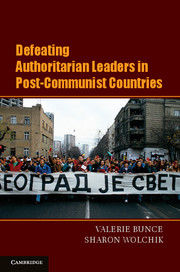2 - Electoral Stability and Change in Mixed Regimes
Published online by Cambridge University Press: 05 June 2012
Summary
One of the most striking features of the ‘late period’ of the third wave has been the unprecedented growth in the number of regimes that are neither clearly democratic nor conventionally authoritarian.
Larry DiamondAll of the elections of interest in this book took place in mixed regimes – that is, regimes that combine authoritarian politics with competition for political office. Our nine regimes also share a common past. Armenia, Azerbaijan, Belarus, Croatia, Georgia, Kyrgyzstan, Serbia, Slovakia, and Ukraine had all been republics nested within federal states during the communist era, and each one of these republics became an independent state in the early 1990s as a consequence of the collapse of communism and the dissolution of the Soviet Union, Yugoslavia, and Czechoslovakia. At the same time, however, these regimes were also very different from one another. For example, it was common practice in some of these countries but not in others for elections to be rigged; the media were relatively free to operate in some cases, but muzzled in the rest; and one leader had ruled since independence in Croatia, Serbia, and Kyrgyzstan, whereas turnovers in leadership had taken place in the remaining members of the group.
The purpose of this chapter is to explore these and other differences among mixed regimes and to generate a series of hypotheses about why opposition parties and candidates might succeed in defeating authoritarian incumbents or their anointed successors.
- Type
- Chapter
- Information
- Publisher: Cambridge University PressPrint publication year: 2011

